Condition states
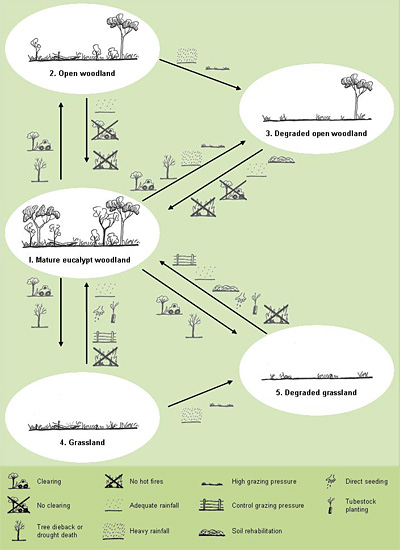

Depending on its management history, land that once supported eucalypt woodland may now support the same vegetation, fewer trees, a different vegetation type, or no trees at all. These are examples of different condition states for eucalypt woodlands.
The ecological model shown on this page describes the different condition states for eucalypt woodlands, and common management pathways to their formation. It also shows how a state can be restored back to the 'mature woodland state' (state 1), which is the maximum carbon state.
The main points are:
- Tree thinning, clearing or dieback (the death of all or part of the tree) of a mature eucalypt woodland (state 1) can reduce carbon stocks and produce an open woodland (state 2) or grassland (state 4).
- Heavy grazing of a mature eucalypt woodland (state 1), with or without heavy rainfall, can produce areas of bare, compacted soil, through both water and wind erosion. This creates a degraded open woodland (state 3) or degraded grassland (state 5).
- The most rapid increase in carbon stocks for an open woodland (state 2) will be achieved by speeding up its development into a mature eucalypt woodland (state 1). This transition may occur slowly under a range of conditions, but will be accelerated if there is adequate rainfall, no clearing and no hot fires.
- States without a eucalypt seed source will require direct seeding or planting.
- Degraded soil may need soil rehabilitation.
- Carbon stocks in a mature eucalypt woodland (state 1) will be maintained if there is adequate rainfall, no clearing and/or hot fires.
- Grazing should be compatible with carbon farming as long as the dying mature trees are replaced at the same rate by new trees growing into the canopy (see managing tree density).
- The target tree density and structure of a reforestation site will depend upon the targeted balance between trees, pasture, biodiversity, and other preferences of the manager.
Identify your site's condition state
To identify the condition state of your site, answer the following questions.
- Are Eucalyptus or Corymbia species present, as saplings or mature trees?
- Do areas of bare, compacted soil cover more than half of the site?
If you answered:
- yes to both questions, you probably have degraded open woodland (state 3).
- yes to 1 and no to 2, you probably have mature eucalypt woodland (state 1) or open woodland (state 2).
- no to both questions, you probably have grassland (state 4).
- no to 1 and yes to 2, you probably have degraded grassland (state 5).
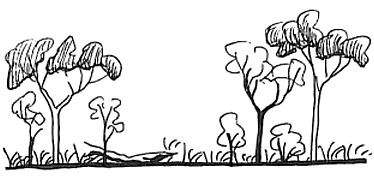
State 1—Mature eucalypt woodland
Eucalyptus and/or Corymbia present as canopy trees (> 2m high) forming a woodland. Ground layer usually dominated by grasses and herbs. Understorey shrubs and small trees are sparse.
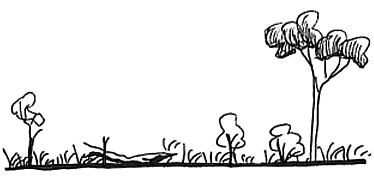
State 2—Open woodland
Primarily grassland with some Eucalyptus and/or Corymbia trees present as seedlings, saplings or mature trees.
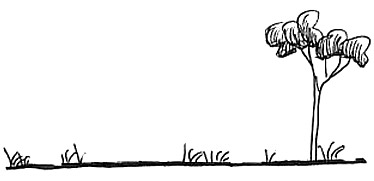
State 3—Degraded open woodland
Primarily grassland with some Eucalyptus and/or Corymbia trees present, as seedlings, saplings or mature trees. Areas of bare, compacted soil cover more than half of the site.

State 4—Grassland
Grassy ground layer with no Eucalyptus and/or Corymbia trees present.
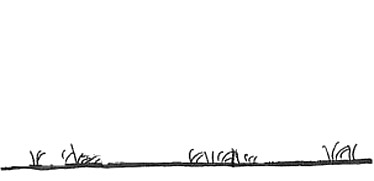
State 5—Degraded grassland
Grassy ground layer with no Eucalyptus and/or Corymbia trees present. Areas of bare, compacted soil cover more than half of the site.
Doesn't seem to fit?
Check the vegetation of your site with the interactive map.
Main management issues
The main management issues for each condition state for eucalypt woodlands are summarised below.
Condition states 1 and 2 have been grouped because their management issues are the same.
Condition state | Description | Main management issue |
|---|---|---|
1 and 2 | Canopy trees present, no extensive areas of bare soil | Areas in these states should require little intervention to sustain or increase their carbon stocks |
3 | Canopy trees and extensive areas of bare soil present | Soil degradation impedes water infiltration and limits plant establishment and growth |
4 | Canopy trees absent, no extensive areas of bare soil | Seed sources for trees and shrubs will be critical to restoration of carbon stocks form the grassland state |
5 | Canopy trees absent, extensive areas of bare soil present | Both seed sources and conditions for plant establishment and growth can limit recovery of degraded grasslands |


